¿Está aprovechando al máximo todas las herramientas a su disposición para mejorar la producción? Conocer y utilizar los indicadores clave de rendimiento (KPI) adecuados puede cambiar el éxito de sus operaciones. Estas métricas ayudan a reducir los tiempos de inactividad y a planificar mejor la producción, mostrando cada parte del proceso de fabricación.
Los KPI para la producción son esenciales en el mundo de la fabricación actual. Ayudan a las empresas a supervisar, analizar y mejorar sus fases de producción. Métricas como la eficacia general de los equipos (OEE), las rotaciones de inventario y las entregas a tiempo permiten a las empresas detectar problemas, reducir residuos y predecir necesidades futuras. Estos indicadores orientan la producción hacia los objetivos al tiempo que se adaptan a los cambios del mercado y del entorno. Esto hace que las operaciones sean más ágiles y eficientes.
Conclusiones Clave
- Utilizar bien los KPI puede mejorar mucho la eficiencia en la fabricación.
- La eficacia global de los equipos (OEE) combina disponibilidad, rendimiento y calidad.
- Las bajas rotaciones de inventario pueden liberar efectivo y satisfacer mejor las necesidades de los clientes.
- La puntualidad en las entregas es clave para complacer a los clientes y animar al personal.
- El seguimiento de las devoluciones de los clientes es crucial para solucionar los problemas en producción.
¿Qué son los KPI de producción?
Los indicadores clave de rendimiento (KPI) de producción son medidas clave en la fabricación. Realizan un seguimiento de la eficacia de los procesos de producción. Estos indicadores ayudan a las empresas a averiguar qué funciona y qué no. De este modo, pueden mejorar y hacer más fluidas sus operaciones.
Definición de los KPI de producción
Los KPI de producción son cifras que muestran cómo el proceso de producción cumple los objetivos. Abarcan factores importantes como el tiempo de ciclo, la tasa de rendimiento y la eficacia general de los equipos (OEE). Su seguimiento permite a las empresas ajustar la producción. También les permite medir el progreso con precisión.
Importancia del seguimiento de los KPI
El valor del seguimiento de los KPI es enorme. Convierten muchos datos en información útil. El seguimiento regular es clave por varias razones:
- Establecimiento y consecución de objetivos: Los KPI permiten fijar objetivos claros. De este modo, las líneas de producción se mantienen a la altura de lo que desea la empresa.
- Identificación de cuellos de botella: Mediante el análisis de los indicadores clave de rendimiento, las empresas pueden detectar rápidamente los retrasos en la producción. Esto les permite solucionar los problemas con rapidez y mantener el buen funcionamiento.
- Mejora de la eficacia del proceso de producción: Centrarse en los KPI ayuda a las empresas a aumentar su eficiencia. Esto significa que pueden ahorrar dinero y fabricar más productos.
Controlar los indicadores clave de rendimiento permite a los fabricantes mejorar sus resultados. Esto es crucial para mantenerse a la cabeza en un mercado que cambia rápidamente.
Tipos de KPI de producción
Existen tres tipos principales de KPI de producción. Se centran en la maquinaria, los productos y la rentabilidad. Conocer estas categorías de KPI ayuda a realizar un mejor seguimiento y a mejorar los procesos de producción.
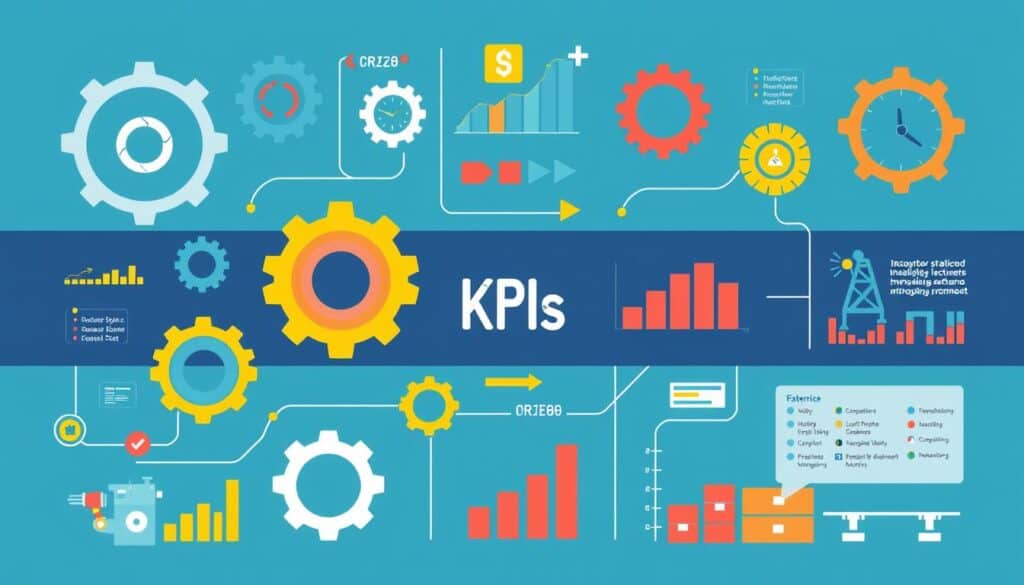
Maquinaria o activos
Este tipo de KPI examina la maquinaria y gestión de activos. Las métricas importantes son:
- Índice de tiempo de actividad de la máquina: mide el tiempo que el equipo permanece operativo. La fórmula es (Tiempo Total Máquina Utilizada / Tiempo de Producción Disponible) * 100. El objetivo es mantener la tasa de tiempo de actividad de la máquina en 90%.
- Tasa de defectos: esto hace un seguimiento de la calidad de lo que se fabrica. La fórmula es el Número de Defectos / Unidades Producidas * 100. El objetivo es reducir la tasa de defectos.
- Eficacia global de los equipos (OEE): comprueba el funcionamiento de la maquinaria. La fórmula es (unidades producidas × duración máxima del ciclo) / tiempo de producción disponible. Queremos aumentar la OEE en 5% este año.
Centrado en la unidad o el producto
En este caso, los KPI analizan el número de unidades o productos, lo que da una idea de cómo va la producción. Las métricas incluidas son:
- Duración del ciclo: esto es lo que dura un ciclo de producción.
- Índice de capacidad de producciónCapacidad: muestra la cantidad máxima de producción posible. Se calcula mediante la tasa de capacidad de la máquina * tiempo.
- Tasa de rendimiento: mide la producción de un producto a lo largo del tiempo.
Centrados en los costes
Los KPI centrados en los costes ayudan a mirar el dinero y mantener los costes bajos en la producción. Las métricas clave son:
- Coste de producción por unidadCoste total de fabricación: mide el coste de fabricación de una unidad. La fórmula es Coste total de fabricación / Número de unidades producidas. El objetivo es reducir el coste de fabricación de una unidad en 2 céntimos para 2022.
- Coste unitario de mantenimientoCoste de mantenimiento: se refiere a los costes de mantenimiento por unidad. Se calcula por Coste Total de Mantenimiento / Número de Unidades Producidas. El objetivo es reducir los costes de mantenimiento por unidad en 5% este año.
- Costes de capacidad no utilizadaEl porcentaje de capacidad disponible no utilizada: comprueba el impacto en los costes de no utilizar toda la capacidad de producción. La fórmula es Porcentaje de capacidad disponible no utilizada × Coste total de fabricación. Nuestro objetivo es reducir la capacidad no utilizada en 10% en 6 meses.
A continuación figura un cuadro con los principales indicadores de estas categorías:
| Tipo de KPI | Métrico | Fórmula | Ejemplo de objetivo |
|---|---|---|---|
| Maquinaria o activos | Tiempo de actividad de la máquina | (Tiempo total máquina utilizada / Tiempo de producción disponible) * 100 | Mantener el tiempo de actividad de cada máquina en 90% |
| Centrado en la unidad o el producto | Tasa de capacidad de producción | Capacidad de la máquina Tasa * Tiempo | Garantizar que cada máquina funcione 90% |
| Centrados en los costes | Coste de producción por unidad | Coste total de fabricación / Número de unidades producidas | Reducir el coste unitario de producción en 2 céntimos para 2022 |
Indicadores clave de rendimiento (KPI) para la producción
Los KPI de producción abarcan muchas métricas clave para evaluar la eficiencia y la productividad de la fabricación. Estos indicadores proporcionan datos que ayudan a los responsables de fabricación a tomar decisiones inteligentes. Trabajan para optimizar las operacionesreducir costes y aumentar la producción. Saber hacer un seguimiento de la fabricación con métricas clave es vital para competir hoy en día.
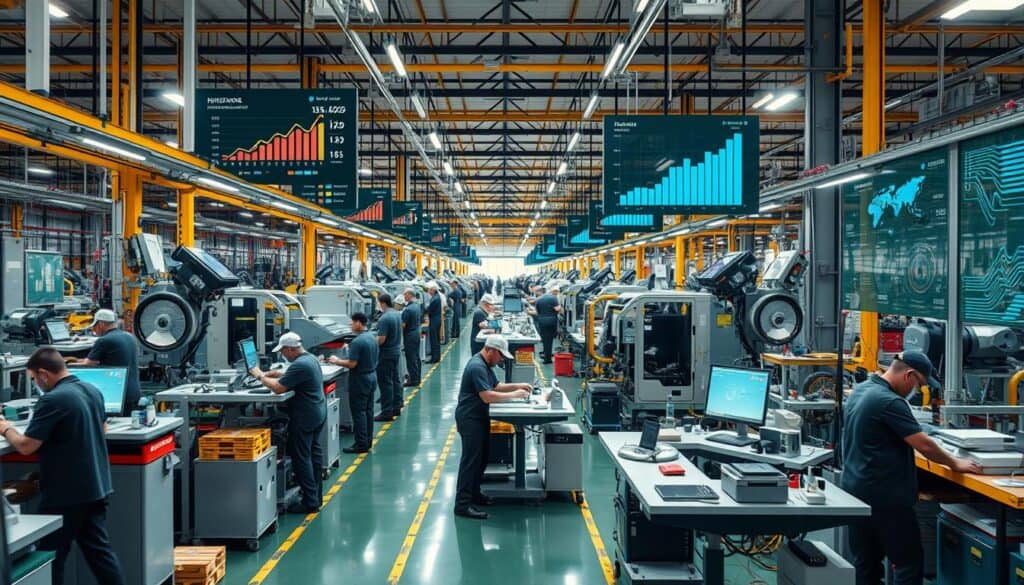
Varios KPI miden diferentes aspectos de la producción. Son cruciales para garantizar la calidad, el mantenimiento de los equipos, el control de costes y la productividad en general. Clave KPI de producción incluyen:
- Ingresos: El total de ingresos por ventas o servicios.
- Margen de beneficio bruto: Porcentaje de ingresos una vez deducido el coste de las mercancías vendidas.
- Return on Investment (ROI): La relación entre beneficios e inversión.
- Captación de clientes: Los nuevos clientes conseguidos en un periodo.
- Retención de clientes: El índice de permanencia de los clientes a lo largo del tiempo.
- Satisfacción de los empleados: Cómo de contentos están los empleados en la empresa.
- Tráfico en la web: El recuento de visitantes del sitio a lo largo del tiempo.
- Tasa de conversión: Porcentaje de visitantes que realizan una acción deseada.
- Rotación de existencias: Con qué frecuencia se venden y reponen las existencias.
- Tiempo de comercialización: El periodo de lanzamiento de un nuevo producto.
Los KPI específicos de fabricación incluyen:
- Cuenta: El total de productos fabricados.
- Ratio de rechazo: La medida de producción de chatarra.
- Utilización de la capacidad: Cuánta capacidad de producción se utiliza.
- Tarifa: La velocidad de producción de bienes.
- Objetivo: Objetivos específicos para los periodos de producción.
- Takt Time: Tiempo necesario para completar una tarea.
- Eficacia global de los equipos (OEE): La eficacia del equipo de producción.
- Tiempo de inactividad: El tiempo en que el equipo de producción está inactivo.
- Duración del ciclo: El tiempo total de un ciclo de producción completo.
- Plazo de entrega: El tiempo que tarda un producto en pasar por el proceso de producción.
Para supervisar bien la fabricación, es fundamental encontrar los KPI más cruciales. Establecer objetivos para cada KPI, y observar y analizar constantemente los datos de los KPI, ayuda a realizar un seguimiento del progreso y a detectar áreas de mejora. Utilizando estos indicadores, los fabricantes pueden obtener mejores resultados y mantenerse a la cabeza del mercado.
| Métrico | Definición |
|---|---|
| OEE | Cálculo: Disponibilidad x Rendimiento x Calidad |
| Total Duración del ciclo | Componentes: Tiempo de producción + Tiempo de inspección + Tiempo de transporte + Tiempo de espera... |
Ha leído 46% del artículo. El resto es para nuestra comunidad. ¿Ya es miembro? Conectarse
(y también para proteger nuestro contenido original de los robots de scraping)
Comunidad.mundial.de.la.innovación
Iniciar sesión o registrarse (100% gratis)
Vea el resto de este artículo y todos los contenidos y herramientas exclusivos para miembros.
Sólo verdaderos ingenieros, fabricantes, diseñadores, profesionales del marketing.
Ni bot, ni hater, ni spammer.
Preguntas frecuentes
¿Qué son los KPI de producción y por qué son importantes?
Los indicadores clave de rendimiento (KPI) de producción miden el éxito del proceso de fabricación. Son vitales para medir la eficiencia, detectar problemas y cumplir objetivos. De este modo se mejora el rendimiento de toda la operación.
¿Qué tipos de KPI de producción deben supervisarse?
Existen tres tipos de KPI de producción. Por un lado, los centrados en la maquinaria o los activos, como el tiempo de actividad de las máquinas. Luego están los centrados en unidades o productos, como tasa de rendimiento. Y los centrados en los costes, por ejemplo, los costes unitarios de producción. Vigilarlos ayuda a mejorar la producción.
¿Cómo se calculan los KPI de producción esenciales?
El cálculo de los KPI de producción utiliza fórmulas específicas. Para la duración del ciclo, reste la hora de inicio de producción de la hora de finalización de producción. Estos métodos de cálculo establecen objetivos claros y permiten realizar un seguimiento de las mejoras.
¿Cuáles son los principales KPI de producción que hay que controlar para mejorar la eficiencia de la fabricación?
Entre los KPI importantes se incluyen el tiempo de ciclo y la tasa de producción. También el logro de la producción y la eficacia general de los equipos (OEE). Muestran la velocidad, la eficiencia y el rendimiento de la fabricación.
Enlaces externos sobre optimización de la producción y la calidad
Normas internacionales
(Pase el cursor sobre el enlace para ver nuestra descripción del contenido)
Glosario de términos utilizados
Cost of Goods Sold (COGS): los costos directos atribuibles a la producción de bienes vendidos por una empresa, incluidos materiales y mano de obra, excluyendo gastos indirectos como costos de distribución y fuerza de ventas.
Key Performance Indicator (KPI): un valor medible que demuestra la eficacia con la que una organización está logrando objetivos comerciales clave, a menudo utilizado para evaluar el éxito en el logro de metas.
Overall Equipment Effectiveness (OEE): Métrica utilizada para evaluar la eficiencia de los procesos de fabricación, calculada multiplicando los índices de disponibilidad, rendimiento y calidad. Identifica pérdidas, lo que permite mejorar la productividad y la eficacia operativa.
Return on Investment (ROI): una métrica financiera utilizada para evaluar la rentabilidad de una inversión, calculada dividiendo la ganancia neta de la inversión por el costo inicial, expresado como porcentaje.
Specific Measurable Achievable Relevant Timely (SMART): un marco para establecer objetivos claros, cuantificables, alcanzables, alineados con objetivos más amplios y limitados en el tiempo, facilitando la planificación y evaluación efectiva del progreso.
Takt Time: El tiempo máximo permitido para producir un producto que satisfaga la demanda del cliente, calculado dividiendo el tiempo de producción disponible entre la producción requerida. Ayuda a sincronizar el ritmo de producción con la demanda, garantizando un flujo de trabajo eficiente y la asignación de recursos.
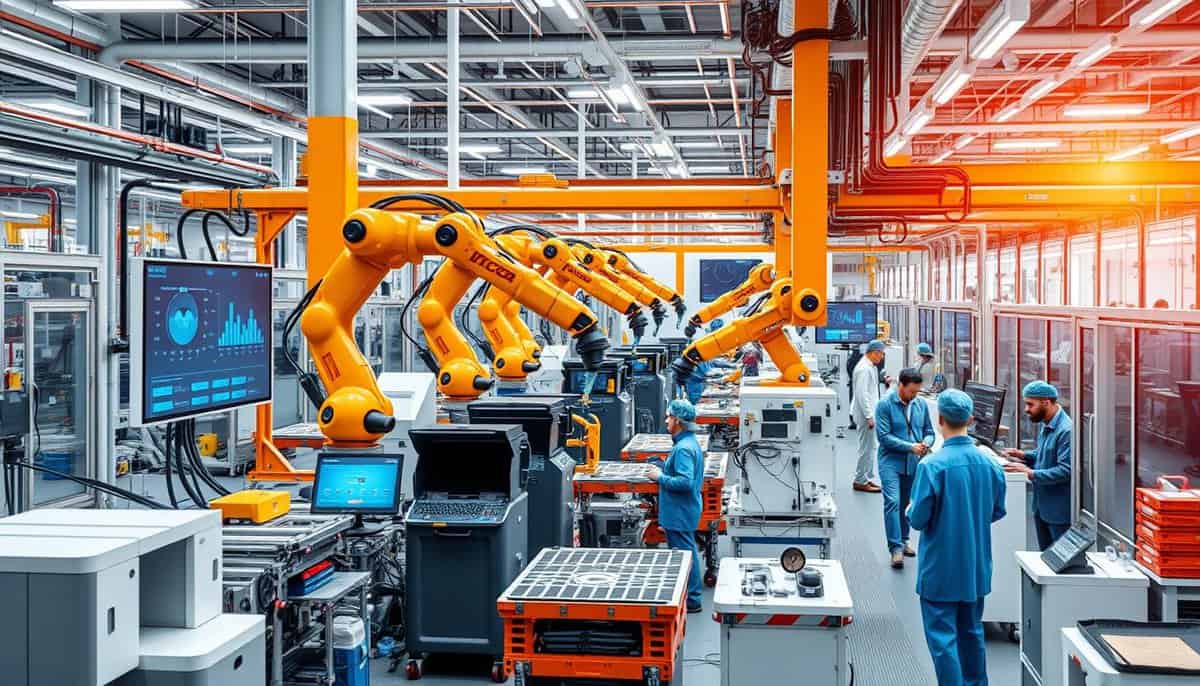





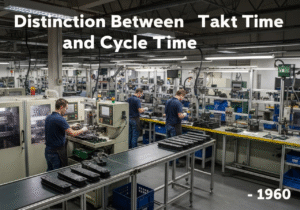

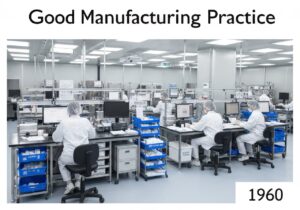
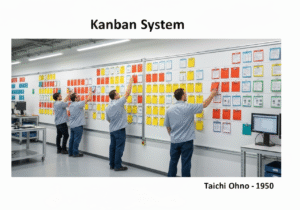


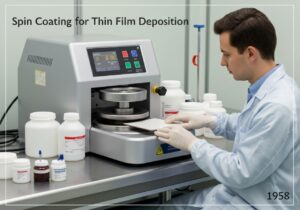

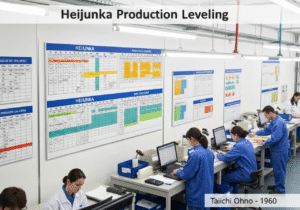
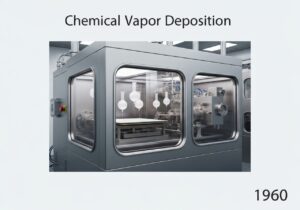


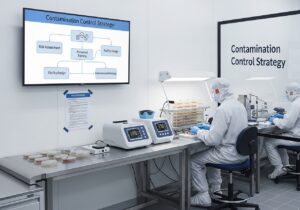
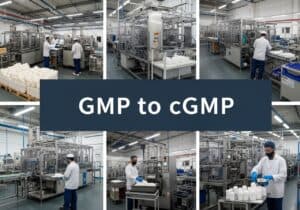






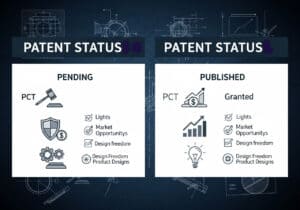
eficacia del seguimiento de los KPI y de la toma de decisiones ?
por favor, incluya más ejemplos de cómo estos KPIs
podría ser interesante debatir cómo la integración de la analítica de datos en tiempo real y la IA puede mejorar aún más la precisión y la eficacia
Interesante lectura. ¿Pero no cree que se hace demasiado hincapié en los indicadores clave de rendimiento? ¿Qué pasa con el elemento humano en la eficiencia de la producción?
Interesante lectura, pero ¿no cree que depender en gran medida de los indicadores clave de rendimiento podría ahogar la creatividad y la innovación en la producción?